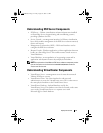
www.dell.com | support.dell.com
16 Deployment Guide
After Installation
After the installation of the ESX Server software in graphics mode, execute
the following steps to complete the installation.
• Create and activate a
swap
file for the VMkernel. The swap file helps in
over-provisioning of the memory to the VMs and results in better
resource management.
• Give a name to the local VMFS partition. This will improve usability
and also preserve access to the local VM disk files, even if one or more
peripheral devices are added or removed.
• Create a
virtual switch
and bind one or more outbound adapters to the
virtual switch, if the VMs in the server require an uplink.
For detailed instructions on how to execute the above steps see the
VMware ESX Server 2.1 Installation Guide
.
SAN Environment Setup with
ESX Server Software
Advanced features such as VMotion technology require a Storage Area
Network (SAN) environment using Dell | EMC CX300, CX500, or CX700
storage devices. Setting up the SAN for ESX Server systems does not require
any special steps. This section provides a quick overview of the general
concepts of a SAN and the steps needed to set up a SAN environment.
LUN:
A Logical Unit Number (LUN) is a unique identifier for a set of one or
more physical disks.
NOTE: A single disk can encompass more that one LUN, but it is not
recommended for performance reasons.
RAID Group:
A RAID Group is a collection of one or more physical disks. In
order to use the LUNs one has to create a RAID group and bind LUNs to it.
Storage Group:
A Storage Group is a set of one or more servers and one or
more LUNs. A server in a Storage Group can only access LUNs which are in
the same Storage Group. Storage Groups are typically used to implement
access control.
X6320bk0.book Page 16 Friday, August 27, 2004 1:35 PM


















